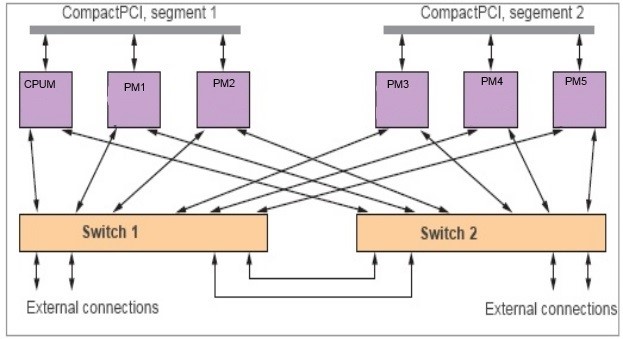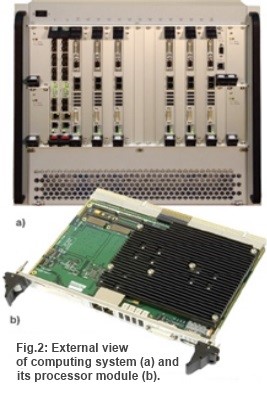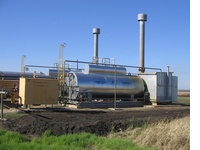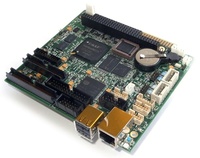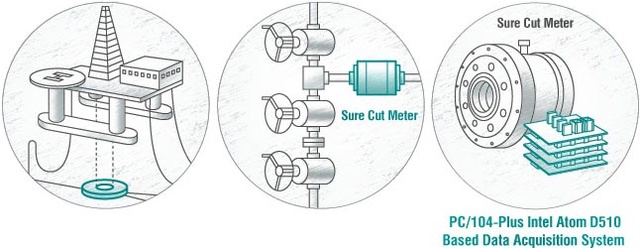The integrated onboard automated control systems are currently considered as advanced and multifunctional platforms providing solutions for a wide range of tasks. In such a case, depending on the type of a vehicle, they can either assist human-operators and expand opportunities (a classic example here is the onboard avionic system on a manned aircraft) or can be the main (sometimes the only one) command center of any self-propelled robotized vehicle (Unmanned aerial vehicles (UAVs), unmanned underwater vehicles (UUVs), spacecraft etc.). The core of such control platforms is the onboard computing system — a special-purpose Box PC, usually controlled by real-time operating system and using peripheral equipment for connection to the systems of data acquisition and vehicle control.
The need for real-time control of the vehicle and for significantly increased processed data flows (e.g. analysis of data from radar stations, recognition of graphic images, encryption/decryption of data flows) imposes very strict requirements on the processing speed of computing system, which determines the growth of its power consumption as well as requirements for power supply and cooling systems accordingly. Under normal conditions, such tasks usually require the use of embedded computers with modular form-factorsbased on modern high-speed serial interfaces such as: CompactPCI Serial, AdvancedTCA, MicroTCA, VXS etc. In this case, when it comes to design, these computers use various standard 19» enclosures and are cooled by powerful fan systems. However, such solutions are usually not suitable for the onboard equipment due to various reasons: consumed power, cooling system capabilities (e.g. gas pressure in the unmanned spacecraft onboard equipment is very low and there is virtually no convection heat transfer). High requirements to vibration and shock resistance of the onboard equipment appear to be quite a different problem since such equipment could be exposed to harsh external effects during motion, which means that the onboard computing system should constantly maintain full operational capability.
In this case the use of computing systems with conduction cooling is seen as a rather efficient solution. This simultaneously provides the system with resistance to mechanical impacts and adequate heat removal. In such a situations heat emission from electronic components is sequentially transferred via several metallic heat-conducting parts to chassis enclosure from which it will be withdrawn by air or to the vehicle’s frame (e.g. when submersible vehicle is used). Today, lots of standards include sub-specifications with conduction cooling. Among the basic standards are VPX (several versions), CompactPCI Serial (in basic specification) and MicroTCA.3.
![3.jpg]()
Below is the description of Fastwel CPU modules and onboard computing system design with conduction cooling based on Fastwel CPC510 which complies with CompactPCI Serial standard.
Fastwel products
![]() The heat removal system is one of the key factors indicating computer reliability. Using the simplified formula, computer operating life is reduced by half as the temperature increases by each 10 °С. The CompactPCI Serial standard is currently defines 2 module cooling types: convection (air) and conduction cooling.
The heat removal system is one of the key factors indicating computer reliability. Using the simplified formula, computer operating life is reduced by half as the temperature increases by each 10 °С. The CompactPCI Serial standard is currently defines 2 module cooling types: convection (air) and conduction cooling.
The system based on conduction cooling is designed for installation of modules sized: 122×162 mm (3U), with a pitch of 5HP. Dimensions of CompactPCI Serial boards with conduction cooling differ from the standard ones. These boards are based on the standard module installed into a metal enclosure. This helps to sufficiently reduce the costs for manufacturing of boards with conduction cooling.
Due to the modifiability of any CompactPCI Serial board equipped with conduction cooling into a module with conduction heat-removal, users enjoy an opportunity to develop such conduction heat-removal systems «on the fly». Application of CompactPCI Serial boards enables to use skills and knowledge that have already been gathered, as well as tried and tested algorithms during upgrade of the already existing and development of new systems.
Fastwel product line includes CompactPCI-modules both with air cooling and conduction cooling. Currently these are the family of 3U devices. The proven Fastwel CompactPCI boards with conduction cooling are used as the basic modules.
All the modules are designed for the operation in industrial temperature range: −40…+85 °C.
Due to the design of modules with conduction heat removal, they often cannot be equipped with the complete set of connectors on the front panel, advanced LED- indication and extension bays. Usually all interfaces required for connection to peripheral devices, are implemented via the backplane and are located in the zone of rear I/O contacts.
![]() CPC510 CPU module is developed for customers as the high integrity solution in CPCI Serial 3U form-factor with a purpose of use in real-time, control and high-speed data acquisition and processing systems. The module’s core is Intel Ivy Bridge CPU (2 cores).
CPC510 CPU module is developed for customers as the high integrity solution in CPCI Serial 3U form-factor with a purpose of use in real-time, control and high-speed data acquisition and processing systems. The module’s core is Intel Ivy Bridge CPU (2 cores).
CPC510 uses high-speed I/O interfaces (PCI-Express, Gigabit Ethernet) and supports modern video processing technologies. The modular design enables to flexibly set the system for a particular application area, optimizing the price-quality ratio.
Reliability of CPC510 makes it possible to use it in all industrial application areas. Components being the basis for CPC510, are carefully selected depending on the criteria of their applicability in harsh environments.
The module has the following structure of I/O channels:
- 2 x Ethernet 1 Gb/s controllers (2 x are routed to the front panel);
- 12 x USB 2.0 ports with support of HS, FS and LS speeds (2 x on the front panel, 2 x on mezzanine board, 8 x on the backplane connector)
- 4 x USB 3.0 ports (routed to the backplane connector)
- 6 x SATA ports (4 x ports are routed to the backplane connector, 1 x on the mezzanine connector, 1 x switchable backplane/mezzanine)
- 1x DisplayPort is routed to the MIC590 board (to the front panel of CPC510-02)
- 1x LVDS is routed to the MIC590 board
- 2x DisplayPort on the front panel
- HD Audio is routed to the mezzanine connector
- LPC is routed to the mezzanine connector
CPC512 CPU module (including its conduction cooling version) will be available soon. The module will be aimed at buildinghigh-performance computing systems, operated in harsh environments and requiring high reliability and flexibility in support of various extension interfaces.The CPC512 module is similar to CPC510, but has some distinctions:
- Instead of 2 x PCI-E switch Gen 2.0, CPC512 has one PCI-E switch Gen 3.0 with increased speed of data transfer (up to 8 Gb/s) and with DMA mode support which significantly reduces CPU load during data transfer. Apart from the retained operability of PCI Express ports in NT mode, the use of the new PCI-E switch Gen 3.0 has added support of the Host failover mode (failsafe mode for two CPC512 modules) for 2 x ports x8, routed to the backplane.
- 2 x ports x4, routed to the backplane, started to support the increased speed of data transfer (up to 8 Gb/s)
- Support of MIC590 mezzanine board has been stopped, this made possible to support PCI Express interface for all the slots of 8x slot backplane. Therefore, 4x PCI Express ports x1 Gen 2.0 are additionally routed to the backplane.
- Support of Gigabit Ethernet operation via backplane with Intel AMT function has been added. The AMT (Advanced Management Technology) function actually is the advanced IPMI (Intelligent Platform Management Interface). It enables to remotely control CPU module operation, change system BIOS settings, reload or turn off the system as well as support Remote Desktop function.
Conduction Cooling System Design
Designing and development of the conduction cooling system usually begins with estimation of heat emission system and choosing the right enclosure which provides removal of the released thermal energy. Additionally, it is necessary to consider a place for enclosure installation, requirements for mechanical and climatic effects. Basically this represents a rather challenging engineering task and usually there are no serial enclosures for systems with conduction cooling. Computers with conduction cooling are always built for particular customers and systems.
![]()
Design of the onboard computing system with conduction cooling includes: modular chassis with backplane, power supply unit and computer modules in special heat-removing enclosures. The modules are secured by special expansion wedge locks and card locks. Therefore, heat will be transferred entirely to the module’s enclosure, from which it will be easily transferred to the enclosure and further to the ambient environment due to the large contact area between the enclosure and chassis frame, together with a high clamping force of wedge locks.
![]() Modular structure of the system based on the platform concept enables users not only to build its system in compliance with the modular principle but also provides its easy expansion and development in the future.
Modular structure of the system based on the platform concept enables users not only to build its system in compliance with the modular principle but also provides its easy expansion and development in the future.
Chassis is usually assembled from machine-cut aluminum components, bolted with each other. For manufacturing of these components various aluminum alloys can be used which correspond to the system customer requirements. Methods of final surface treatment can also vary: electrolytic anodizing (the best method in terms of the heat dissipation), electroless nickel plating, yellow chromate conversion coating etc. The chassis enclosure can be finned on the outside for the purpose of heat-removal improvement and can have a range of mounting holes and flanges for attaching various accessories, holding brackets and additional covers. The front and rear covers are usually symmetrical, can have different depths and can be reworked in accordance with customer requirements — equipped with holes for external connectors and switches.
Design of the chassis should provide the most efficient contact transfer of heat from active components to the chassis enclosure. System is manufactured in metallic enclosure, but first a detailed computer-aided simulation of its thermal conditions will be carried out. Its results will be used for project’s rework and it will be simulated until the result is considered fully appropriate.
![]()
Why to Choose Fastwel
![]() Fastwel customers can always contact company’s engineers during design of the systems based on Fastwel CPU boards. Engineers will help selecting the right enclosures and systems either on the basis of System Partners product line (Elma) or based on Fastwel projects. Due to the long-term partner relations with leading companies specializing in the development and manufacturing of enclosures and chassis, Fastwel customers obtain professional technical support from a single source, and can count not only on module level solutions, but also on getting turnkey systems, manufactured in accordance with their individual requirements and corresponding to the most strict demands of industry standard, which even more contributes to applicability of Fastwel CompactPCI modules.
Fastwel customers can always contact company’s engineers during design of the systems based on Fastwel CPU boards. Engineers will help selecting the right enclosures and systems either on the basis of System Partners product line (Elma) or based on Fastwel projects. Due to the long-term partner relations with leading companies specializing in the development and manufacturing of enclosures and chassis, Fastwel customers obtain professional technical support from a single source, and can count not only on module level solutions, but also on getting turnkey systems, manufactured in accordance with their individual requirements and corresponding to the most strict demands of industry standard, which even more contributes to applicability of Fastwel CompactPCI modules.



















